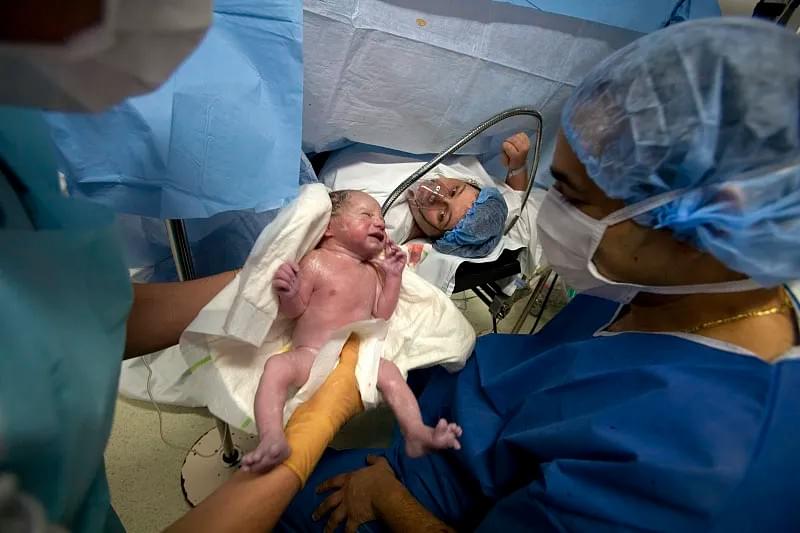Surrogacy offers a beacon of hope for individuals and couples facing infertility, same-sex partners, and others who cannot carry a pregnancy themselves. While it is a joyful and transformative journey for many, it's essential to recognize that surrogacy, like any pregnancy, comes with its own set of medical considerations. One of the most critical aspects prospective parents and intended surrogates must understand is the possibility of a high-risk pregnancy.
Understanding what constitutes a high-risk pregnancy in the context of surrogacy can empower all parties to make informed decisions, prepare adequately, and ensure the best possible outcomes for both the surrogate and the baby. This comprehensive guide explores the factors that contribute to high-risk pregnancies in surrogacy, the medical protocols involved, emotional considerations, and how to navigate this complex but rewarding path.
What Defines a High-Risk Pregnancy?
A high-risk pregnancy is one in which the life or health of the mother or fetus is at increased risk due to various medical, physical, or environmental factors. These pregnancies require more frequent monitoring, specialized care, and sometimes interventions to manage complications.
In traditional pregnancies, risk factors include advanced maternal age, pre-existing conditions like diabetes or hypertension, multiple gestations (twins or more), and lifestyle factors. In surrogacy, many of these same risks apply — but the dynamics are different. The surrogate, not the intended parent(s), carries the pregnancy, so her health and medical history become central to risk assessment.
It’s important to note that not all surrogacy pregnancies are high-risk. Many proceed smoothly with standard prenatal care. However, due to the nature of assisted reproductive technology (ART) and the selection criteria for surrogates, certain factors may elevate the risk profile.
Common Risk Factors in Surrogacy Pregnancies
Several factors can contribute to a high-risk classification in surrogacy. Understanding these helps in planning, screening, and managing expectations.
1. Multiple Gestations
One of the most significant contributors to high-risk pregnancies in surrogacy is carrying twins or triplets. While transferring multiple embryos was once common to increase success rates, current medical guidelines strongly recommend single embryo transfer (SET), especially in surrogacy.
Why? Multiple pregnancies significantly increase the risk of:
- Preterm labor and birth
- Low birth weight
- Preeclampsia
- Gestational diabetes
- Cesarean delivery
Intended parents may be tempted to transfer more than one embryo to increase the chances of success, but this can lead to complications that outweigh the benefits. Reputable surrogacy agencies and fertility clinics now advocate for SET to reduce maternal and fetal risks.

2. Surrogate’s Medical History
Even the healthiest women can experience complications, but a thorough medical screening helps identify potential red flags. Surrogates are typically required to have:
- A history of uncomplicated, full-term pregnancies
- No history of preeclampsia, gestational diabetes, or preterm labor
- A healthy body mass index (BMI)
- No chronic conditions like hypertension or autoimmune disorders
However, unforeseen issues can arise. For example, a surrogate with a previously normal pregnancy may develop gestational diabetes or preeclampsia during the surrogacy pregnancy. This is why continuous monitoring is essential.
3. Advanced Maternal Age of the Egg Donor or Intended Mother
While the surrogate carries the baby, the genetic material often comes from an older intended mother or an egg donor. Advanced maternal age (typically 35 and older) increases the risk of chromosomal abnormalities such as Down syndrome. This doesn’t directly affect the surrogate’s health but may influence prenatal testing decisions and emotional preparedness.
Preimplantation genetic testing (PGT) can screen embryos for genetic disorders before transfer, reducing some of these risks. However, PGT is not foolproof, and some conditions may only be detectable during pregnancy.
4. Underlying Fertility Issues of Intended Parents
The reasons behind the need for surrogacy — such as uterine factor infertility, recurrent miscarriage, or medical contraindications to pregnancy — may indicate underlying health issues that could indirectly affect the pregnancy. While these don’t impact the surrogate directly, they may influence the medical team’s approach to monitoring and care.
Medical Management of High-Risk Surrogacy Pregnancies
When a surrogacy pregnancy is classified as high-risk, the medical team adjusts care accordingly. This often involves:
1. Increased Prenatal Monitoring
High-risk pregnancies require more frequent ultrasounds, non-stress tests, and biophysical profiles. These help monitor fetal growth, amniotic fluid levels, and placental function.
The surrogate will likely see a maternal-fetal medicine (MFM) specialist, also known as a perinatologist, in addition to her regular OB-GYN. These specialists are trained to manage complex pregnancies and can intervene early if complications arise.
2. Early and Comprehensive Testing
Beyond standard prenatal screenings, high-risk surrogacy pregnancies may involve:
- First-trimester combined screening (nuchal translucency scan + blood tests)
- Cell-free DNA testing (non-invasive prenatal testing, or NIPT)
- Amniocentesis or chorionic villus sampling (CVS) if indicated
These tests help detect genetic conditions, placental issues, or fetal anomalies early, allowing for informed decision-making.
3. Lifestyle and Dietary Guidance
Surrogates receive detailed guidance on nutrition, exercise, and lifestyle modifications. For example:
- A diet rich in folic acid, iron, and protein
- Avoiding alcohol, tobacco, and certain medications
- Managing stress through mindfulness or counseling
Agencies often provide nutritionists and mental health support to ensure the surrogate’s well-being.

Emotional and Psychological Considerations
A high-risk pregnancy can be emotionally taxing — not just for the surrogate, but for the intended parents as well. The stress of potential complications can strain relationships and impact mental health.
For the Surrogate
Even though she is not genetically related to the baby (in gestational surrogacy), the surrogate forms a physical and emotional bond during pregnancy. Worrying about the baby’s health or her own well-being can lead to anxiety or depression. It’s crucial that surrogates have access to independent counseling and emotional support throughout the journey.
For Intended Parents
Intended parents may feel helpless, especially if they live far from the surrogate. They may experience guilt, fear, or frustration. Open communication with the surrogate and the medical team is vital. Many agencies offer support groups or therapy sessions to help intended parents navigate these emotions.
Building a strong, trusting relationship with the surrogate — based on mutual respect and clear boundaries — can significantly ease the emotional burden during a high-risk pregnancy.
Legal and Ethical Dimensions
High-risk pregnancies also raise legal and ethical questions that should be addressed before conception.
1. Informed Consent
All parties must fully understand the risks involved. The surrogacy agreement should outline:
- Who makes medical decisions if complications arise
- Protocols for emergency interventions
- Stance on selective reduction in the case of multiples
- Financial responsibilities for extended medical care
These discussions, though difficult, are essential to prevent conflict later.
2. Selective Reduction and Termination
In rare cases, a high-risk multiple pregnancy may require selective reduction (reducing the number of fetuses) to improve outcomes. Similarly, if severe fetal abnormalities are detected, termination may be considered.
These decisions are deeply personal and must be agreed upon in advance. The surrogate retains the right to bodily autonomy, so her consent is paramount. Clear, compassionate dialogue and legal documentation are crucial.

How to Minimize Risks in Surrogacy
While not all risks can be eliminated, several proactive steps can reduce the likelihood of a high-risk pregnancy:
1. Choose a Reputable Agency and Fertility Clinic
Work with agencies and clinics that follow evidence-based practices, such as single embryo transfer and thorough medical screening. Look for accreditation, success rates, and transparent communication.
2. Prioritize Surrogate Health and Screening
Ensure the surrogate undergoes comprehensive medical and psychological evaluations. Her history of healthy pregnancies is a strong predictor of future success.
3. Embrace Single Embryo Transfer (SET)
Despite the emotional desire for twins, SET significantly reduces risks. Modern IVF techniques have improved success rates, making SET a safer and increasingly effective option.
4. Maintain Open Communication
Regular updates between the surrogate, intended parents, and medical team foster trust and allow for quick responses to any concerns.
5. Invest in Support Services
Provide access to mental health professionals, nutritionists, and legal advisors. Emotional and logistical support can make a significant difference in outcomes.
Real-Life Scenarios: Learning from Experience
Let’s consider two real-world examples:
Case 1: Successful Singleton Pregnancy
Sarah, a 32-year-old surrogate, carried a single embryo for a same-sex male couple. She had two previous uncomplicated pregnancies. Throughout her surrogacy journey, she attended all prenatal visits, followed nutritional guidance, and remained in close contact with the intended parents. The pregnancy progressed smoothly, and she delivered a healthy baby at 39 weeks.
Case 2: Managing a High-Risk Twin Pregnancy
Jessica, a 35-year-old surrogate, was transferred two embryos due to the intended mother’s age and egg quality concerns. She became pregnant with twins. At 24 weeks, she developed signs of preeclampsia. She was hospitalized for monitoring, delivered at 34 weeks via C-section, and both babies spent two weeks in the NICU. While the outcome was positive, the experience was physically and emotionally demanding.
These cases highlight the importance of risk assessment and preparation.

Conclusion: Navigating High-Risk Surrogacy with Confidence
Surrogacy is a profound act of generosity and love. While the possibility of a high-risk pregnancy exists, understanding the contributing factors, medical protocols, and emotional dynamics can help all parties navigate the journey with greater confidence and peace of mind.
By prioritizing health, communication, and ethical practices, intended parents and surrogates can work together to achieve the best possible outcome — the birth of a healthy child. Advances in reproductive medicine, combined with compassionate care and thorough planning, continue to make surrogacy a safe and rewarding option for building families.
If you’re considering surrogacy, consult with experienced professionals, ask questions, and ensure you’re fully informed. Knowledge is your most powerful tool in turning dreams of parenthood into reality.
